![]()
![]()
![]()
Use LEFT and RIGHT arrow keys to navigate between flashcards;
Use UP and DOWN arrow keys to flip the card;
H to show hint;
A reads text to speech;
71 Cards in this Set
- Front
- Back
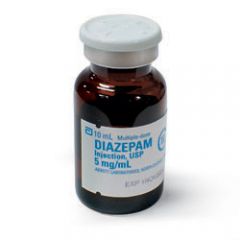
GENERIC NAME
diazepam |
diazepam
|
|
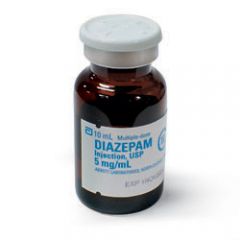
BRAND NAME
diazepam |
Valium
|
|
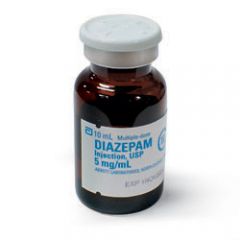
CLASS
diazepam |
benzodiazepine
|
|
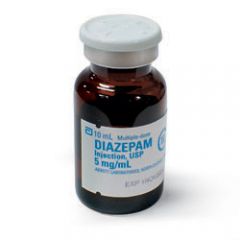
INDICATIONS AND FIELD USE
diazepam |
Grand mal seizures, especially status epilepticus
Transient analgesia/amnesia for medical procedures (e.g., fracture reduction, cardioversion, pacing) Delirium tremens Treat the cause first |
|
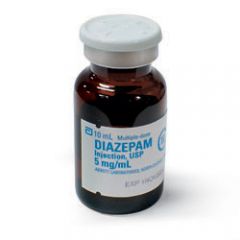
ADULT DOSAGE
diazepam |
2 mg increments slow IV/IO push. Administer no faster than 2 mg/minute
|
|
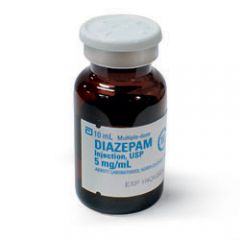
BONUS
diazepam |
Incompatibilities/drug interactions:
Do not mix or dilute diazepam with other solutions or drugs in syringe, tubing or IV container Special notes: Valium must be injected slowly and small veins such as those on the dorsum of the hand or wrist should be avoided Risk of venous thrombosis, phlebitis, local irritation, swelling and vascular spasm is increased Extreme care must be taken to avoid intra-arterial injection or extravasation Diazepam may cause prolonged CNS depression in the neonate (30 days of age or less) |
|
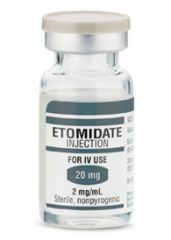
GENERIC NAME
etomidate |
etomidate
|
|
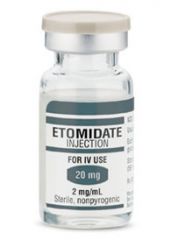
BRAND NAME
etomidate |
Etomidate
|
|
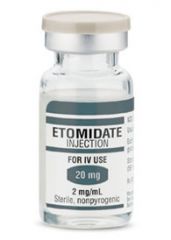
CLASS
etomidate |
sedative/hypnotic agent
|
|

INDICATIONS AND FIELD USE
etomidate |
Induction of anesthesia for rapid sequence intubation (RSI)
|
|

ADULT DOSAGE
etomidate |
0.3 mg/kg IV/IO over 30-60 seconds
|
|
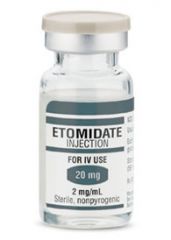
BONUS
etomidate |
Onset of action:
1 minute Duration of action: 3-5 minutes |
|
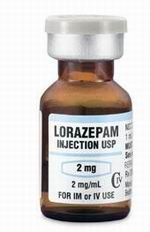
GENERIC NAME
lorazepam |
lorazepam
|
|
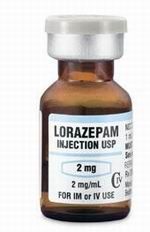
BRAND NAME
lorazepam |
Ativan
|
|

CLASS
lorazepam |
antianxiety; benzodiazepine, short or intermediate acting
|
|
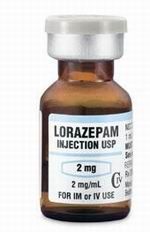
INDICATIONS AND FIELD USE
lorazepam |
Status epilepticus
Seizure Agitation |
|
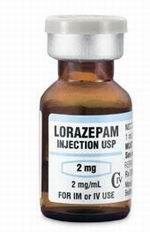
ADMINISTRATION
lorazepam |
IM: Should be administered deep into the muscle mass
IV/IO: Do not exceed 2 mg/minute or 0.05 mg/kg over 2-5 minutes **Inadvertent intra-arterial injections may produce arteriospasm resulting in necrosis and potential amputation |
|
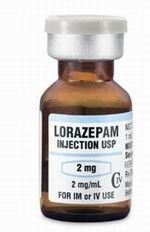
ADULT DOSAGE
lorazepam |
Status epilepticus: 2 mg to 4 mg IV/IO given slowly (over 2-5 minutes. May repeat dose in 10-15 minutes if needed (maximum 8 mg). May give IM if no IV access
|
|
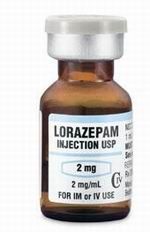
BONUS
lorazepam |
Incompatibilities/drug interactions:
Concomitant use of CNS sedatives such as phenothiazines, narcotic analgesics, barbiturates, antidepressants, and alcohol should be assessed prior to administration of IV lorazepam Special notes: Care must be used when administering lorazepam IV to elderly patients, seriously ill patients, and those with limited pulmonary reserve as apnea and/or cardiac arrest may occur Patients over the age of 50 years may have a more profound and prolonged sedation with IV lorazepam All patients should be monitored for respiratory depression and hypotensive effects Stability above room temperature has not been established |
|
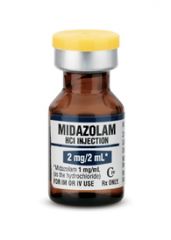
GENERIC NAME
midazolam hydrochloride |
midazolam hydrochloride
|
|
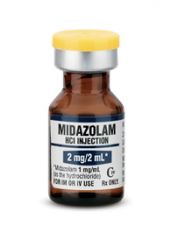
BRAND NAME
midazolam hydrochloride |
Versed
|
|
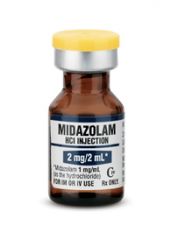
CLASS
midazolam hydrochloride |
central nervous system depressant, benzodiazapine
|
|
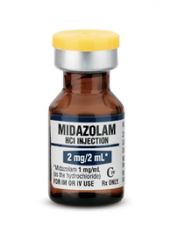
INDICATIONS AND FIELD USE
midazolam hydrochloride |
Anti-convulsant
Sedation Management of acute agitation/treat cause first Induction for intubation |
|

ADULT DOSAGE
midazolam hydrochloride |
Patients 14 to 60 years of age: 1 to 5 mg IV (2 to 5 mg IM), titrate to effect, administer slowly in small increments of no more than 2.5 mg over at least 2 minutes
Patients over 60 years of age: 1 to 3.5 mg IV (1 to 3 mg IM), titrate to effect, administer slowly in small increments of no more than 1.5 mg over at least 2 minutes Total dose: Should not exceed 20 mg For emergency intubation: 0.1 mg/kg up to 0.3 mg/kg with dosage limit of 20 mg Seizures: 0.2 mg/kg IM for status seizures if no IV access |
|
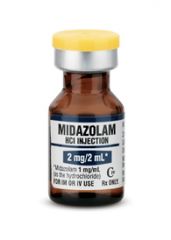
BONUS
midazolam hydrochloride |
Incompatibilities/drug interactions:
Midazolam may potentiate other CNS depressants, including opiate agonists or other analgesics, barbiturates or other sedatives, anesthetics, or alcohol Erythromycin may double the half-life of midazolam Special Notes: Flumazenil is the accepted antagonist for midazolam |
|
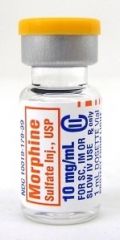
GENERIC NAME
morphine sulfate |
morphine sulfate
|
|
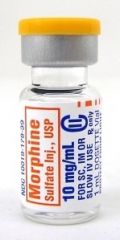
BRAND NAME
morphine sulfate |
Morphine Sulfate
|
|
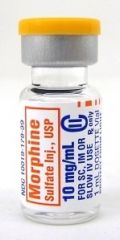
CLASS
morphine sulfate |
narcotic agonist
|
|
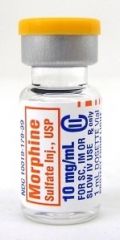
INDICATIONS AND FIELD USE
morphine sulfate |
Analgesia, especially in patients with burns, myocardial infarction, or renal colic
Pulmonary edema (cardiogenic) |
|

ADULT DOSAGE
morphine sulfate |
Administer 2-4 mg increments slow IV/IO PUSH until pain is relieved up to 20 mg, if systolic is > 90
IM: 5-10 mg if no IV access if systolic > 90 |
|
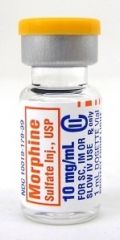
BONUS
morphine sulfate |
Incompatibilities/drug interactions: CNS side effects (including respiratory depression) can be reversed by naloxone
Special notes: Schedule II narcotic Watch for histamine effects (wheals, urticaria) proximal to IV site; contact medical control Correct hypotension before administration Maximum respiratory depression 7-10 minutes after administration; can be reversed with naloxone; caution in patients with emphysema IV infusions of morphine sulfate may be transported, however an infusion pump is required |
|
|
GENERIC NAME
nitrous oxide 50% |
nitrous oxide 50%
|
|
|
BRAND NAME
nitrous oxide 50% |
Nitronox
|
|
|
CLASS
nitrous oxide 50% |
analgesic, inhalation
|
|
|
INDICATIONS AND FIELD USE
nitrous oxide 50% |
Moderate to severe pain from musculoskeletal trauma, burns, AMI
|
|
|
ADULT DOSAGE
nitrous oxide 50% |
Self-administer and self-regulated by the patient, who must hold the mask to face to create an airtight seal until the pain is significantly relieved or the patient drops the mask
|
|
|
BONUS
nitrous oxide 50% |
Dosage forms/packaging: Nitrous oxide machine that delivers a fixed ratio of nitrous oxide and oxygen (50:50) utilizing a mixing valve with separate tanks of N2O and O2 with a fail safe device (O2 tank empty, no nitrous flows) and a self-administation mask
|
|
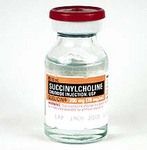
GENERIC NAME
succinylcholine |
succinylcholine
|
|
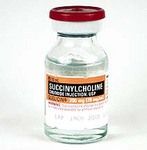
BRAND NAME
succinylcholine |
Succinylcholine
|
|
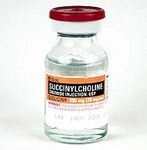
CLASS
succinylcholine |
ultra-short acting depolarizing-type skeletal muscle relaxant
|
|
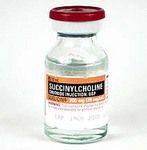
INDICATIONS AND FIELD USE
succinylcholine |
Endotracheal intubation requiring paralysis (RSI) by a qualified EMT-P
|
|
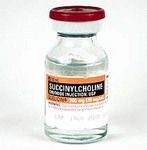
ADULT DOSAGE
succinylcholine |
1.5 mg/kg IV push, may repeat in 2-3 minutes to achieve paralysis
|
|
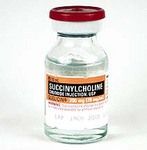
BONUS
succinylcholine |
Incompatibilities/drug interactions: Beta-blockers, procainamide, lithium, and quinidine prolong the effects
Duration of action: Muscle paralysis lasting 4-6 minutes Special Notes: *Succinylcholine should not be given to patients for the period from 24 hours to 21 days after significant burns or crush injury due to elevated potassium levels and potential for cardiac dysrhythmias |
|
|
MECHANISM OF ACTION
Diazepam |
Acts on parts of the limbic system, the thalamus, and hypothalamus producing calming effects; decreases seizures by increading the seizure threshold; transient analgesia; amnesic; sedative
|
|
|
CONTRAINDICATIONS
Diazepam |
Hypersensitivity (allergy)
Glaucoma, acute narrow angle (relative) |
|
|
ADVERSE REACTIONS
Diazepam |
CV: Bradycardia, hypotension, cardiovascular collapse; venous thrombosis; phlebitis; vascular spasm
Resp: Respiratory arrest; may be prolonged in neonates CNS: Somnolence, confusion, coma, diminished reflexes Other: Burning proximal to IV injection site; local irritation; swelling; extravasation will cause tissue necrosis |
|
|
PEDIATRIC DOSAGE
Diazepam |
IV/IO Dose: 0.1 - 0.2 mg/kg (max of 2.0 mg/dose); may repeat x 3 every 5 minutes
Rectal dose (< or = 6 years): 0.5 mg/kg rectally via ANGIOCATH (max of 10 mg) |
|
|
MECHANSIM OF ACTION
Lorazepam |
Agent bings highly to the gamma-amino butyric acid (GABA) benzodiazepine receptor complex without displacing GABA, (GABA is the major inhibitory neurotransmitter in the brain). It exerts tranquilizing action on the central nervous system.
|
|
|
CONTRAINDICATIONS
Lorazepam |
Known sensitivity to the benzodiazepines
Acute narrow angle glaucoma or myasthenia gravis Known hypersensitivity to polyethylene glycol, propylene glycol, or benzyl alcohol Pregnancy |
|
|
ADVERSE REACTIONS
Lorazepam |
Most frequent adverse reaction is sedation
Transient amnesia or memory impairment Confusion Hypotension Respiratory depression Dizziness Headache |
|
|
PEDIATRIC DOSAGE
Lorazepam |
Status epilecticus: 0.05 - 0.1 mg/kg IV/IO over 2-5 minutes (maximum 4 mg). May repeat in 10-15 minutes
|
|
|
MECHANISM OF ACTION
midazolam hydrochloride |
CNS effects are mediated through the inhibitory neurotransmitter gamma-aminobutyric acid (GABA).
Acts at the limbic, thalamic, and hypothalamic levels of the CNS, producing anxiolytic, sedative, hypnotic, and anticonvulsant effects. Capable of producing all levels of CNS depression, from mild sedation to coma |
|
|
CONTRAINDICATIONS
midazolam hydrochloride |
Hypersensitivity to midazolam
Relative contraindication in: myasthenia gravis or other neuromuscular disorders; acute alcohol intoxication; sever COPD; and acute pulmonary insufficiency |
|
|
ADVERSE REACTIONS
midazolam hydrochloride |
CV: hypotension (especially in patients premedicated with narcotic); cardiac arrest; irregular or fast heartbeat
Resp: Apnea; respiratory depression, respiratory arrest; hyperventilation; wheezing or difficulty in breathing; hiccups; coughing CNS: emergence delirium; muscle tremor; uncontrolled or jerky movements of body; unusual excitement, irritability, or restlessness; dizziness, light-headedness, or feeling faint; prolonged drowsiness; headache GI: nausea and/or vomiting |
|
|
PEDIATRIC DOSAGE
midazolam hydrochloride |
Pediatric patients: 0.05 to 0.1 mg/kg slow IV push
0.2 mg/kg IM for status seizures if no IV access |
|
|
MECHANISM OF ACTION
morphine sulfate |
Alleviates pain by acting on the pain receptors in the brain; elevates pain threshold
Depresses central nervous system; depresses brainstem respiratory centers; decreases responsiveness to changes in PaCO2 Increases venous capacitance (venous pooling), vasodilates arterioles, reducing preload and afterload Histamine release |
|
|
CONTRAINDICATIONS
morphine sulfate |
Respiratory depression
Head injuries Elevated intra cranial pressure Asthma, relative Abdominal pain, relative |
|
|
ADVERSE REACTIONS
morphine sulfate |
CV: brady or tachydysrhythmias, orthostatic hypotension
Resp: Respiratory depression or arrest CNS: Excess sedation, seizures to coma and arrest, pupillary constriction GI: nausea and vomiting, GI spasm Derm: Histamine release may cause local urticaria |
|
|
PEDIATRIC DOSAGE
morphine sulfate |
Age < 14 years: IV/IO 0.1 mg/kg. May repeat to a max total dose or 0.2 mg/kg. Max total dose of 10 mg.
|
|
|
MECHANISM OF ACTION
etomidate |
Produces hypnosis rapidly causing CNS depression and anesthesia
No analgesic effect |
|
|
CONTRAINDICATIONS
etomidate |
Hypersensitivity
|
|
|
ADVERSE REACTIONS
etomidate |
Transient muscle movements
Apnea Causes minimal but not clinically significant suppression of cortisol levels May cause myoclonus and tremors that can resemble seizure activity |
|
|
PEDIATRIC DOSAGE
etomidate |
None
|
|
|
MECHANISM OF ACTION
nitrous oxide 50% |
Centrally acting agent that produces CNS depression and elevation of the pain threshold
|
|
|
CONTRAINDICATIONS
nitrous oxide 50% |
Unconscious patient
Poor respiratory drive, compromise of respiratory status (i.e. pneumothorax) Abdominal pain unless intestinal obstruction has been completely ruled out Severe head injury |
|
|
ADVERSE REACTIONS
nitrous oxide 50% |
Resp: worsening or pre-existing pneumothorax; may cause hypercarbia in oxygen sensitive patients (CO2 retainers)
GI: nausea and vomiting, may lead to rupture of intestine if administered to patient with intestinal obstruction |
|
|
PEDIATRIC DOSAGE
nitrous oxide 50% |
Must be old enough to follow the instructions for use and large enough that the mask creates an airtight seal
|
|
|
MECHANISM OF ACTION
succinylcholine |
Combines with cholinergic receptors of the motor end plate to produce depolarization
Hydrolyzed by acetylcholinersterase |
|
|
CONTRAINDICATIONS
succinylcholine |
Muscle disorders
Personal or family history of malignant hyperthermia History of hyperkalemia Burn injured patients Ocular injuries Patients in whom successful endotracheal intubation is doubtful |
|
|
PEDIATRIC DOSAGE
succinylcholine |
None
|
|
|
ADVERSE REACTIONS
succinylcholine |
vagal stimulation leading to bradycardia or systole
hyperkalemia rhabdomyolysis hypersalivation elevated intraocular pressure release of histamine |

